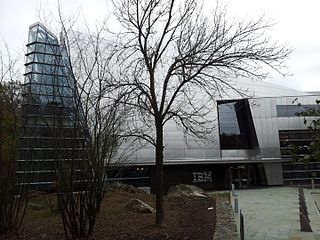This page is based on this
Wikipedia article Text is available under the
CC BY-SA 4.0 license; additional terms may apply.
Images, videos and audio are available under their respective licenses.
Time Sharing Option (TSO) is an interactive time-sharing environment for IBM mainframe operating systems, including OS/360 MVT, OS/VS2 (SVS), MVS, OS/390, and z/OS.

IBM Information Management System (IMS) is a joint hierarchical database and information management system with extensive transaction processing capabilities.

Customer Information Control System (CICS) is a family of mixed language application servers that provide online transaction management and connectivity for applications on IBM mainframe systems under z/OS and z/VSE.
UNIX System Services (USS) is a required, included component of z/OS. USS is a certified UNIX operating system implementation optimized for mainframe architecture. It is the first UNIX 95 to not be derived from the AT&T source code. Through integration with the rest of z/OS, additional Time Sharing Option (TSO) commands are available alongside the usual UNIX services, making it possible to process UNIX files using ISPF. Extensions in JCL make it possible to use these files in batch processing.
Systems Application Architecture (SAA), introduced in 1987, is a set of standards for computer software developed by IBM. The SAA initiative was started in 1987 under the leadership of Earl Wheeler, the "Father of SAA". The intent was to implement SAA in IBM operating systems including MVS, OS/400 and OS/2. AIX, IBM's version of the UNIX operating system, was not a target of SAA, but does have interoperability with the SAA family.
WebSphere Application Server (WAS) is a software product that performs the role of a web application server. More specifically, it is a software framework and middleware that hosts Java-based web applications. It is the flagship product within IBM's WebSphere software suite. It was initially created by Donald F. Ferguson, who later became CTO of Software for Dell. The first version was launched in 1998.
OfficeVision is an IBM proprietary office support application that primarily runs on IBM's VM operating system and its user interface CMS. Other platform versions are available, notably OV/MVS and OV/400. OfficeVision provides e-mail, shared calendars, and shared document storage and management, and it provides the ability to integrate word processing applications such as Displaywrite/370 and/or the Document Composition Facility (DCF/SCRIPT). IBM introduced OfficeVision in their May 1989 announcement, followed by several other key releases later.
In computing, a Parallel Sysplex is a cluster of IBM mainframes acting together as a single system image with z/OS. Used for disaster recovery, Parallel Sysplex combines data sharing and parallel computing to allow a cluster of up to 32 systems to share a workload for high performance and high availability.
IBM Spectrum Protect is a data protection platform that gives enterprises a single point of control and administration for backup and recovery. It is the flagship product in the IBM Spectrum Protect family.
In computing, Advanced Program to Program Communication or APPC is a protocol which computer programs can use to communicate over a network. APPC is at the application layer in the OSI model, it enables communications between programs on different computers, from portables and workstations to midrange and host computers. APPC is defined as VTAM LU 6.2
Teleprocessing Network Simulator (TPNS)
is an IBM licensed program, first released in 1976 as a test automation tool to simulate one or many network terminal(s) to a mainframe computer system, for functional testing, regression testing, system testing, capacity management, benchmarking and stress testing. In 2002, IBM re-packaged TPNS and released
Workload Simulator for z/OS and S/390 (WSim) as a successor product.
IBM Workload Scheduler is a software that plans, executes and tracks jobs on several platforms and environments. Its main purpose is to manage the computing resources on collections of computers ("clusters") to allow different users to efficiently share these resources to run parallel programs.
IBM's Cross System Product (CSP) was an application generator intended to create online systems on IBM's mainframe platforms. Introduced in 1981, CSP consisted of a set of source code generators that allowed developers to interactively define, test, generate, and execute application programs. CSP was composed of two products:
The history of operating systems running on IBM mainframes is a notable chapter of history of mainframe operating systems, because of IBM's long-standing position as the world's largest hardware supplier of mainframe computers.

OS/360, officially known as IBM System/360 Operating System, is a discontinued batch processing operating system developed by IBM for their then-new System/360 mainframe computer, announced in 1964; it was heavily influenced by the earlier IBSYS/IBJOB and Input/Output Control System (IOCS) packages. It was one of the earliest operating systems to require the computer hardware to include at least one direct access storage device.
SMP/E "is a tool designed to manage the installation of software products on [a] z/OS system and to track the modifications" to those products.
Rational solution for Collaborative Lifecycle Management (CLM) is an integrated Application Lifecycle Management solution comprising four products: Rational Requirements Composer, Rational Team Concert, Rational Quality Manager and Rational Software Architect Design Manager. CLM is developed by the Rational brand of IBM and was first released in 2011. CLM is used to coordinate software development activities across business and system requirements, design, development, build, test, and delivery.




